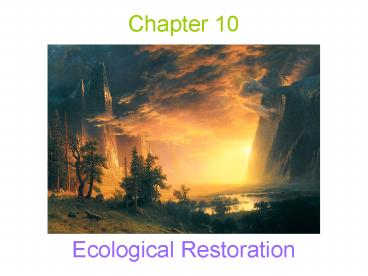Ecological Restoration - PowerPoint PPT Presentation
Title:
Ecological Restoration
Description:
Chapter 10 Ecological Restoration The Balance of Nature An environmental myth that states that the natural environment, when not influenced by human activity, will ... – PowerPoint PPT presentation
Number of Views:425
Avg rating:3.0/5.0
Title: Ecological Restoration
1
Chapter 10
- Ecological Restoration
2
The Balance of Nature
- An environmental myth that states that the
natural environment, when not influenced by human
activity, will reach a constant status,
unchanging over time.
3
What needs to be restored?
- Wetlands, Rivers and Streams
- (Ex Kissimmee River, Everglades National Park)
- Prairie Restoration
- (Ex Allwine Prairie)
4
(No Transcript)
5
When Nature Restores Itself The Process of
Ecological Succession
- Ecological Succession
- The process of the development of an ecological
community or ecosystem. - Two Types
- Primary Succession The initial establishment and
development of an ecosystem - Secondary Succession The reestablishment of an
ecosystem where there are remnants of a previous
biological community
6
Patterns in Succession
- An initial kind of vegetation specially adapted
to the unstable conditions - Small plants and other early-successional species
grow and seeds spread rapidly. - Larger plants and other late successional species
enter and begin to dominate the site. - A mature forest develops.
- Examples of Succession
- Dune Succession, Bog Succession, Old-Field
Succession
7
Bog Succession
8
(No Transcript)
9
Succession and Chemical Cycling
- Biomass, production, diversity and chemical
cycling change during succession - Biomass and diversity peak in mid-succession,
increasing at first to a maximum, then declining
and varying over time.
10
(No Transcript)
11
Species Change in Succession
- Earlier and later species in succession may
interact in three ways - Facilitation
- Interference
- Life history differences
- If they do not interact, the result is termed
chronic patchiness
12
Facilitation
- During succession, one species prepares the way
for the next (and may even be necessary for the
occurrence of the next)
13
Interference
- During succession, one species prevents the
entrance of a later species into an ecosystem. - Ex) Some grasses produce dense and thick mats so
the seeds of trees cannot reach the soil to
germinate
14
(No Transcript)
15
Life History Difference
- The difference in the life histories of the
species allow some time to arrive first and grow
quickly, while others arrive late and grow more
slowly - Ex) seed disbursal































